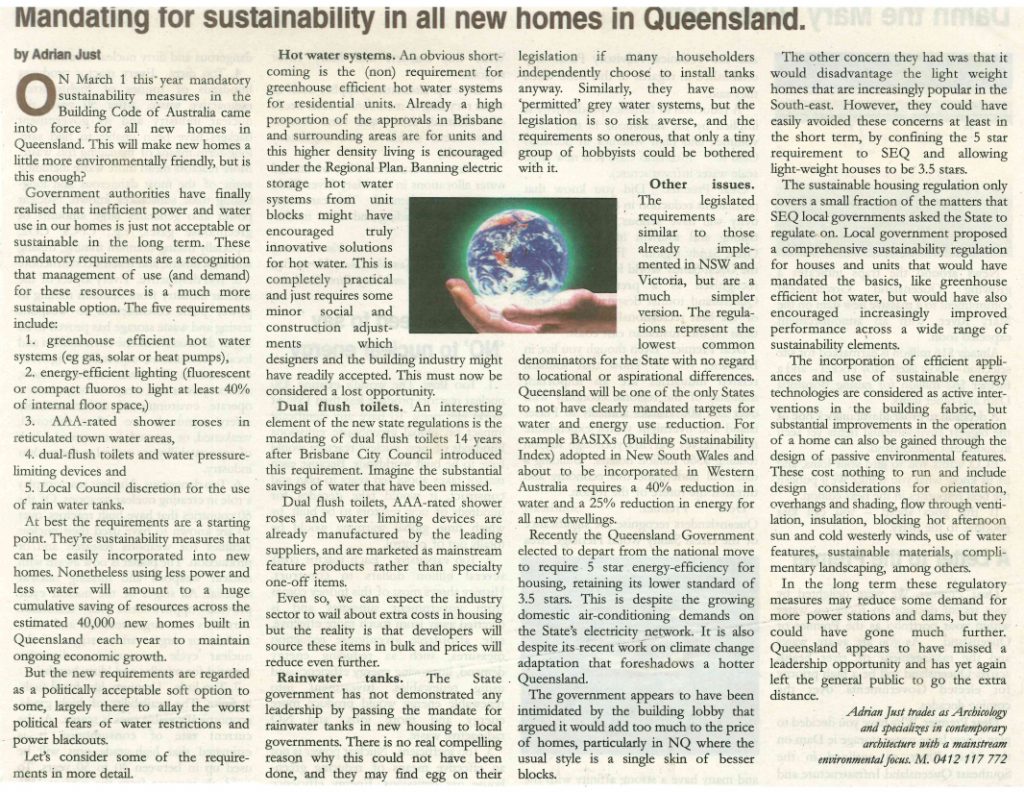 ON March 1 this year mandatory sustainability measures in the Building Code of Australia came into force – for all new homes in Queensland. This will make new homes a little more environmentally friendly, but is this enough?
ON March 1 this year mandatory sustainability measures in the Building Code of Australia came into force – for all new homes in Queensland. This will make new homes a little more environmentally friendly, but is this enough?
Government authorities have finally realised that inefficient power and water use in our homes is just not acceptable or sustainable in the long term. These mandatory requirements are a recognition that management of use (and demand) for these resources is a- much more sustainable option. The five requirements include:
- greenhouse efficient hot water systems (eg gas, solar or heat pumps),
- energy-efficient lighting (fluorescent or compact fluoros to light at least 40% of internal floor space,)
- AAA-rated shower roses in reticulated town water areas,
- dual-flush toilets and water pressure-limiting devices and
- Local Council discretion for the use of rain water tanks.
At best the requirements are a starting point. They’re sustainability measures that can be easily incorporated into new homes. Nonetheless using less power and less water will amount to a huge cumulative saving of resources across the estimated 40,000 new homes built in Queensland each year to maintain ongoing economic growth.
But the new requirements are regarded as a politically acceptable soft option to some, largely there to allay the worst political fears of water restrictions and power blackouts.
Let’s consider some of the requirements in more detail.
Hot water systems. An obvious short-coming is the (non) requirement for greenhouse efficient hot water systems for residential units. Already a high proportion of the approvals in Brisbane and surrounding areas are for units and this higher density living is encouraged under the Regional Plan. Banning electric storage hot water systems from unit blocks might have encouraged truly innovative solutions for hot water. This is completely practical and just requires some minor social and construction adjustments which designers and the building industry might have readily accepted. This must now be considered a lost opportunity.
Dual flush toilets. An interesting element of the new state regulations is the mandating of dual flush toilets 14 years after Brisbane City Council introduced this requirement. Imagine the substantial savings of water that have been missed.
Dual flush toilets, AAA-rated shower roses and water limiting devices are already manufactured by the leading suppliers, and are marketed as mainstream feature products rather than specialty one-off items.
Even so, we can expect the industry sector to wail about extra costs in housing but the reality is that developers will source these items in bulk and prices will reduce even further.
Rainwater tanks. The State government has not demonstrated any leadership by passing the mandate for rainwater tanks in new housing to local governments. There is no real compelling reason why this could not have been don; and they may find egg on their
legislation if many householders independently choose to install tanks anyway. Similarly, they have now `permitted’ grey water systems, but the legislation is so risk averse, and the requirements so onerous, that only a tiny group of hobbyists could be bothered with it.
Other issues. The legislated requirements are similar to those already implemented in NSW and Victoria, but are a much simpler version. The regulations represent the lowest common denominators for the State with no regard to locational or aspirational differences. Queensland will be one of the only States to not have clearly mandated targets for water and energy use reduction. For example BASIXs (Building Sustainability Index) adopted in New South Wales and about to be incorporated in Western Australia requires a 40% reduction in water and a 25% reduction in energy for all new dwellings.
Recently the Queensland Government elected to depart from the national move to require 5 star energy-efficiency for housing, retaining its lower standard of 3.5 stars. This is despite the growing domestic air-conditioning demands on the State’s electricity network. It is also despite its-recent work on climate change adaptation that foreshadows a hotter Queensland.
The government appears to have been intimidated by the building lobby that argued it would add too much to the price of homes, particularly in NQ where the usual style is a single skin of besser blocks.
The other concern they had was that it would disadvantage the light weight homes that are increasingly popular in the South-east. However, they could have easily avoided these concerns at least in the short term, by confining the 5 star requirement to SEQ and allowing light-weight houses to be 3.5 stars.
The sustainable housing regulation only covers a small fraction of the matters that SEQ local governments asked the State to regulate. on. Local government proposed a comprehensive sustainability regulation for houses and units that would have mandated the basics, like greenhouse efficient hot water, but would have also encouraged increasingly improved performance across a wide range of sustainability elements.
The incorporation of efficient appliances and use of sustainable energy technologies are considered as active interventions in the building fabric, but substantial improvements in the operation of a home can also be gained through the design of passive environmental features. These cost nothing to run and include design considerations for orientation, overhangs and shading, flow through ventilation, insulation, blocking hot afternoon sun and cold westerly winds, use of water features, sustainable materials, complimentary landscaping, among others.
In the long term these regulatory measures may reduce some demand for more power stations and dams, but they could have gone much further. Queensland appears to have missed a leadership opportunity and has yet again left the general public to go the extra distance.







